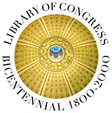
HOME -
GLOSSARY -
CREDITS
Sections:
Newspapers & Periodicals -
Manuscripts -
Photographs
Prints, Posters, & Drawings -
Books -
Maps -
Music -
Sound & Film
Newspapers
& Periodicals
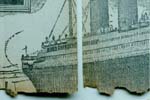
Detail of
damage to newspaper due to creasing.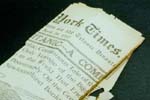
The newspaper was stored, folded,
prior to treatment.
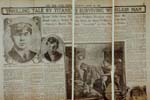
A flattened sheet of the newspaper is split,
reinforced, and reassembled.
| Extra! Sinking of Titanic
New York Times
1 special supplement, newsprint
April 28, 1912
Serial & Government Publications
Division
While other New York newspapers provided better early coverage of the Titanic disaster, this
New York Times special supplement appeared two weeks after the sinking. It
provided the public with detailed information about events leading up to the accident and actions
taken in its immediate aftermath.
Treatment: This issue exemplifies the challenge of preserving highly
acidic newsprint in its original form. The brittle, folded and cracked paper could not be opened
without damage. The Library of Congress sent it to the ZFB company in Leipzig, Germany, to
undergo an experimental new "paper-splitting" treatment.
The German conservators smoothed the sheets, faced each with tissue, attaching it with a
gelatin adhesive, and pressed the faced pages. They pulled each page apart into two separate
sheets, and inserted an acid-free core paper between them. After treatment, they encapsulated the
pages in polyester film. Researchers can now read the original supplement if they handle it with
care. |
|
"First in war, first in peace, and first in the hearts of his
country"
Ulster County Gazette
(Kingston, NY)
January 4, 1800
1 issue, rag paper
Serial
& Government Publications Division
The Ulster
County Gazette was established May 5, 1798, at Kingston, New York, by Samuel Freer
and Son as a weekly Federalist newspaper. The newspaper is unremarkable except for a single
issue, which commands more attention than all of its rivals put together, that of January 4, 1800.
On page two of this four-page issue appears John Marshall's address on the death of George
Washington. Marshall concluded his remarks to the U.S. House of Representatives with the
now-famous phrase, "First in war, first in peace, and first in the hearts of his country."
Treatment:
Conservators washed the single rag paper sheet, mended it, and placed it between two plexiglass
sheets in order to permit safe viewing of all four pages of the open newspaper. | 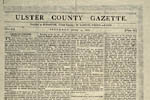
Ulster County
Gazette
page 1- page 2-
page 3- page 4
Enlarged
versions:
page 1- page
2- page 3- page 4
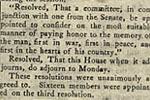
Excerpt of John Marshall's speech containing the phrase
"...first in war, first in peace, first in the hearts of his country," (located toward the
end of the the third column).
|
|
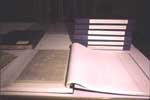
Newspaper volumes after
treatment
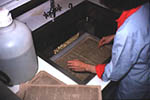
A paper conservator washes the acidic sheets, prior to applying an
agent to remove acid and leave an alkaline reserve. |
Voice of the
Government
Daily National Inteligencer (Washington, D.C.)
Joseph
Gailes and William W. Seaton, 1813-1869
223 volumes, rag paper.
Serial & Government
Publications Division
The Daily National
Intelligencer served as the semiofficial newspaper of the U.S. government until Andrew
Jackson's administration. It carried full coverage of Congressional actions and debates in
addition to governmental notices, proclamations and advertisements. In the first quarter of the
1800s, virtually all other newspapers based their news of the government on the reports of the
National Intelligencer. During the War of 1812, it was one of the few private
enterprises in Washington destroyed by the British.
Treatment: The newspaper leaves were taken out of their original,
library-style bindings, which had caused pages to tear along the spine edge. Although the pages
were initially made from good quality cotton rag pulp, they had grown acidic due poor storage
conditions. The pages were washed and deacidified. However, they were still soft, weak, stained
and torn along the edges. Conservators mended tears with an all-rag paper lens tissue coated with
acrylic resin. Using rice starch paste, they attached a strong Japanese paper "guard" to each
sheet. The mended pages were then interleaved with sheets of acid-free paper so readers can turn
the pages easily. |
|
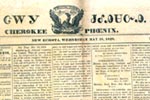 | Cherokee Phoenix
Elias Boudinott
[Cherokee Phoenix]
4 volumes, rag paper,
March 6, 1828-Oct. 19, 1833
Serials &
Government Publications Division
On February 21, 1828, the Cherokee Nation became the
first Native American tribe with a tribal newspaper. It was printed "partly with English, and
partly with Cherokee print; and all matter which is common interest will be given in both
languages in parallel columns." Included were printed tribal laws, official notices, news articles,
prayers, and historical descriptions in Cherokee and English.
Treatment: The original bindings of the Cherokee Phoenix
were standard library style: half leather or cloth spines with paper sides. Conservators disbound
the newspaper leaves and washed and deacidified them. They mended tears with an all-rag paper
lens tissue coated with acrylic resin. They encapsulated the pages in polyester sheeting. To
complete the treatment, they created a book structure for each volume of newspaper leaves.
|
|
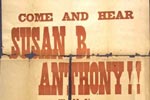
Before treatment
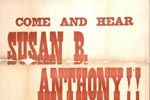
After treatment
|
This poster announcing a suffrage rally in Hyde Park is from the Susan B. Anthony
scrapbooks. Anthony folded the poster and placed it in one of her 34 scrapbooks, which contain
programs, tickets, photographs, manuscripts, and other ephemera documenting the woman
suffrage movement.
The scrapbooks are of utmost importance in understanding the progress of woman suffrage in
America. They were compiled from 1848 through 1900, and with passing years, some of the
items in the scrapbooks have degenerated. This poster is one exemplifies a conservation
treatment that restored a piece of American history to a state in which it can be viewed and
appreciated. Treatment:
Because of the size of the poster, it had been folded several times, resulting in breaks and
separations. Conservators washed the poster item aligned all the fragments before lining the
assembled pieces with Japanese tissue paper and wheat starch paste. This treatment not only kept
all the pieces together, but added support to the poster. Conservators completed the treatment by
encapsulating the poster in polyester sheeting to make it easier for researchers to handle.
|
|
Preservation Microfilming Projects
Lithuanian Yiddish
Periodicals
General Collections
Division
The Library's Preservation Reformatting
Division is inspecting and preparing for use 429 positive and 429 negative microfilm reels of
Yiddish and Hebrew
periodical titles from the National Library of Lithuania through the ongoing Department of
Defense microfilming project.
Titles include: Di Tsayt (Vilnius, Lithuania), Vilner Radyo (Vilnius, Lithuania), Ovent
Kuryer, Hayntike Nays, Yidishe Tsaytung, Di Idishe Shtime, Folksblat, Vilner Kuryer, Idenshtat
in A.I., Dos Vort, and Frimorgn.
|
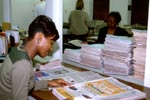
Library staff members collate series of items and prepare them for
filming. |
New Delhi
Microfilming Project
Asian Division
Through this ongoing project, the Library annually receives large quantities of microfilm or
microfiche of South and Southeast Asia serials and monographs. The Library receives on
average 10,000 microfiche a year and in 1999 received
approximately 18,000 rolls of microfilm.
|
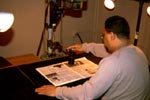
Photographers check the light levels to ensure that the film
reproduces the item accurately. Great care is taken during filming to maintain consistency
throughout a reel of microfilm.
|
Francis
Long Collection of Plays and Other Theatrical Works
Microfilm Reading
Room
Francis Long Collection of plays and
other theatrical works contain items published in English from 1607-1812. The collection was
filmed in 1981. This extensive collection contains 2,105 bound plays and 331 volume sets.
|

Library staff reviews each reel of microfilm for quality and
prepares an inventory and a finding aid of the contents.
|
Records of
Russian Orthodox Greek Catholic Church of North America
Photoduplication
Service
Records of Russian Orthodox Greek
Catholic Church of North America were microfilmed and the collection totaled 376 reels. This
important collection, provides value information for researchers into many aspects of American
life.
|
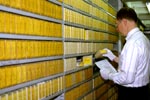
Master negatives are stored in a climate controlled vault to ensure longevity. When
copies of microfilm reels are ordered for purchase by a researcher, they are made from a copy
negative.
|
Military
Archives:
Former Warsaw Pact Countries
European
Reading Room
Through the ongoing Department of
Defense microfilming project, the Library received positive and negative reels of declassified
records from the Centralne Archiwum Wojskowe in Warsaw covering the early years of the Cold
War, primarily 1945-1950.
This collection includes letters, memoranda, policy papers of the Polish Cabinet Ministers, the
Minister of Defense, the General Staff, and other high military bodies.
|
|
Within this collection of 975 pamphlets
on 20 reels is found information on pre-Hispanic leaders in America, including Acamapichtli,
Axatacatl, and Cuitlahuac; on colonial figures such as Sor Juana Ines de la Cruz, Hernando
Alvarado Tezozomoc, and Gonzalo Fernandez de Oviedo y Valdes; and on 19th and 20th
century political, literary and other cultural figures.
The predominant segment of items relates to 20th century figures such as presidents and writers
from throughout the Americas and Iberia, although there are also pamphlets on major 19th
century figures such as Simon Bolivar, Jose Artigas, Andres Bello, Ruben Dario, Jose Marti,
Francisco Miranda, Jose de San Martin, and Domingo Faustino Sarmiento.
|
Reports of
the South Manchurian Railway Company
Asian
Reading Room
At the request of Japan's National Diet
Library, the Photoduplication Service in cooperation with the Japanese Section, Asian Division,
microfilmed 3,270 reports prepared by the South Manchurian Railway Company (Minami
Manshu Tetsudo Kabushiki Kaisha).
Acquired by the Library after World War II, the reports are a valuable sociological and legal
source of information about the Japanese people working in the pre-Communist rural
communities of Manchuria
Members of the Diet and many Japanese citizens, especially former employees of this Japanese
company, have been vitally interested in these unique reports.
|
The Latin
American Microfilm Project (LAMP) for Memorias
Microfilm Reading
Room
The documents filmed under this project
are official reports, constituting a large body of published information on the administrative,
diplomatic, economic, cultural, fiscal, and social life of every Spanish speaking country in the
Western Hemisphere and Brazil, that provide a rich statistical as well as analytical vein of
information to scholars in the field.
In 1986, a grant proposal from LAMP, a consortium of about 30 research libraries in the United
States and Canada, was approved by the National Endowment for the Humanities (NEH) for the
preservation microfilming of the annual reports of the Latin American ministries (commonly
known as Memorias, Informes, and Relatorios) from the time of their independence (the early
1800's) through 1959.
The goal of this project was to assemble and preserve records of primary historical materials that
were in danger due to scarcity, aging and deterioration, and to make them more widely available
through the Center for Research Libraries (CRL), which serves as a depository for the microfilm
produced by this project and makes the film available on loan to all LAMP-member libraries.
After surveying Library holdings, officials decided to do the filming in the Library of Congress
because of the strength of its Memoria/Informe holdings, and its reputation for high quality
preservation microfilming.
As of June 1998, a total of 115 titles and more than 3,500 volumes were filmed, producing
about 6,000 reels.
|
|
Gennadii Vasilevich Yudin (1840-1912)
was a liquor merchant and bibliophile from Krasnoiarsk, who assembled with his profits the
largest private library in Russia. His was principally a Russian-language collection, strong in
bibliography, history, literature and ethnography, and contained many materials on Siberia.
Yudin paid considerable attention to historical sources: with a complete collection of the Russian
chronicles and numerous publication of historical and archaeological societies.
In 1898 Yudin advertised to sell his library to various Russian institutions for 250,000 rubles,
with the stipulation that the collection was to remain intact. In OCtober 1902, Alexis Babine, an
emigre representing the Slavic Section of the Library ofCongress, learned of the possible sale and
traveled to Krasnoiarsk. Although initial negotiations failed, in 1905 babine published a
description of the collection, which pleased Yudin and on November 3, 1906 the agreement of
sale was signed.
From 1992 to 1995 Preservation Reformatting Division prepared over 400 brittle monograph
titles for microfilming from the European Division's Yudin Collection.
|
Copyright Music Deposits, 1870-1885
Music Division
In 1870, the United States Copyright Office was established in the Library of Congress, Washington, D.C., as the central respository for copyrighted materials including music. Certain deposited music items were selected, classified, and added to the Library's collections. Eventually, the majority of these items came under the custody of the Music Division.
During 1982-1985, the Photoduplication Service, completed a projecet to microfilm music materials deposited in the Copyright Office from 1870 through 1885, but not added to the Library's collections. The collection comprises 466 microfilm rolls.
|
|
The National Park Service began the Historic American Buildings Survey in 1933, and the Federal Government took its first major step toward cataloging and preserving historic structures. In 1934, the National Park Service, American Institute of Architects, and the Library of Congress agreeed to conduct a survey on a permanent basis. Under this agreement, the National Park Service selects subjects for recording, and the Library of Congress preserves the records and makes them available for study.
In 1982, the Photoduplication Service completed the microfilming
of the 45,000 photographs and 35,000 pages of written
documentation of the Historic American Buildings Survey,
which is housed un the Library's Prints and Photographs
Division. This work was done for the British publishing
firm Chadwyck-Healey, Ltd., which produced a microfiche
edition (1,4000 microfiche sheets) of the Historic American
Buildings Survey. This publication made an important Library
collection accessible to researchers throughout the world.
|
|
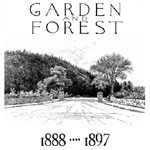
Clicking on the above image will take you to the Library's digitized
version.
| Garden and Forest:
A Journal of Horticulture,
Landscape Art, and Forestry
Preservation Reformatting
Division
Garden and Forest was the
first American journal devoted to horticulture, botany,
landscape design and preservation, national and urban
park development, scientific forestry, and the
conservation of forest resources. The journal was
established by Charles Sprague Sargent (1841-1927),
the founding director of the Arnold Arboretum of
Harvard University.
Treatment: The Preservation Reformatting
Division used LC
preservation specifications to
produce this digital reproduction of all ten volumes,
comprising 8,400 pages and over 1,000 photographs
and other illustrations. |
|

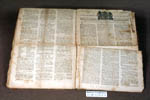
 |
A weekly newspaper established in Hartford, Connecticut
on October 29, 1764 by Thomas Green, the Connecticut Courant was
the third newspaper published in the colony and an ancestor
of the modern Hartford Courant.Following the British
occupation of New York in 1776, the Courant assumed
leadership as a spokesman for the Revolution. When paper
became so scarce that some issues were printed on wrapping
paper, published Ebenzer Watson built his own paper mill.
Circulation is said to have reached 8,000 in 1778, when many
colonial papers numbered their subscribers at a few hundred.
In September of 1777 Hannah Watson assumed control of the
paper after her husband's death.
Treatment: The textblock was removed from
its original binding and the individual leaves were washed
and then alkalized with magnesium bicarbonate. The leaves were
sized by immersion in methyl cellulose and mended with Japanese
tissue and wheat starch paste. The volume was rebound and placed
in a specially constructed drop spine box. |
|
HOME -
GLOSSARY -
CREDITS
Sections:
Newspapers & Periodicals -
Manuscripts -
Photographs
Prints, Posters, & Drawings -
Books -
Maps -
Music -
Sound & Film
|

